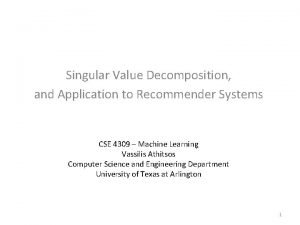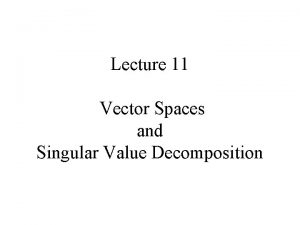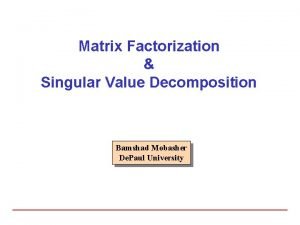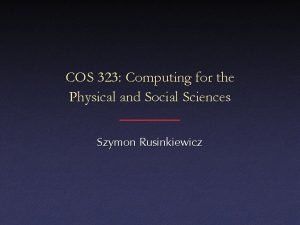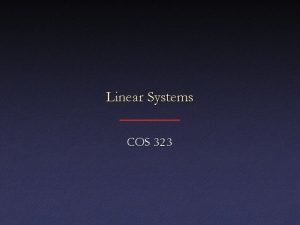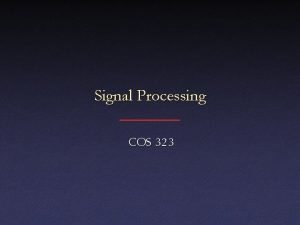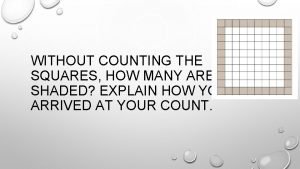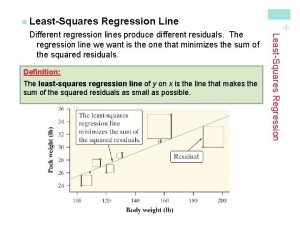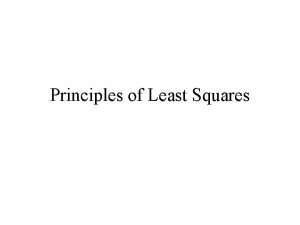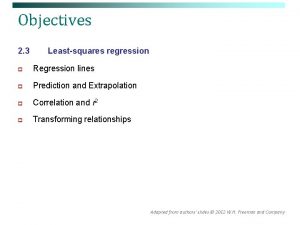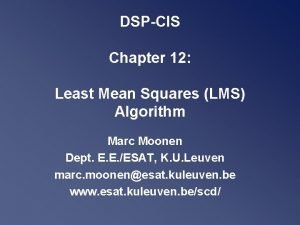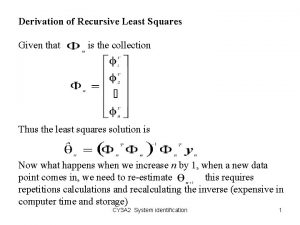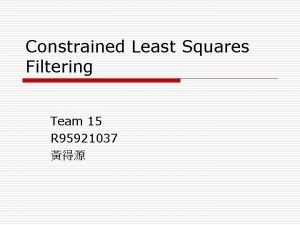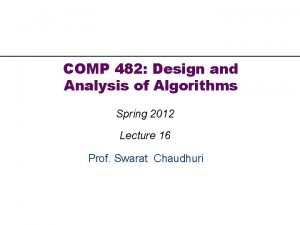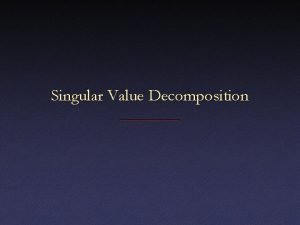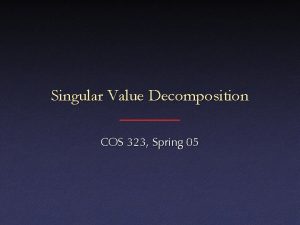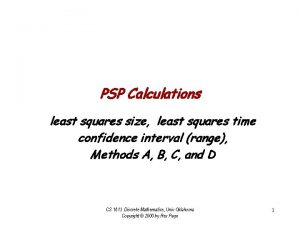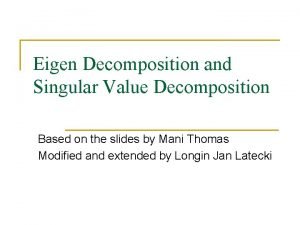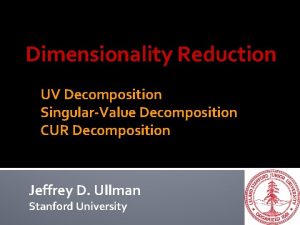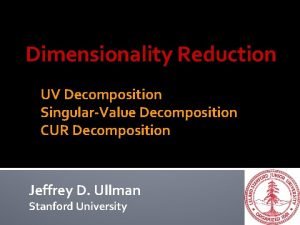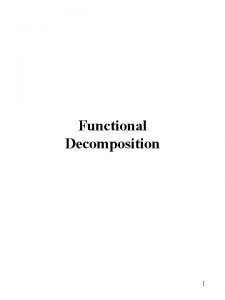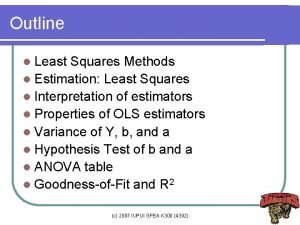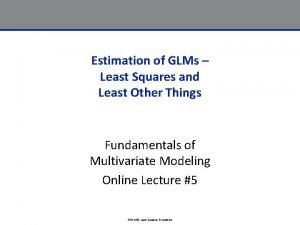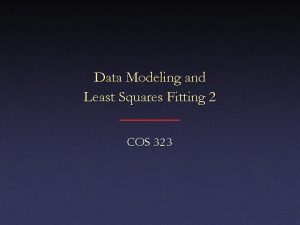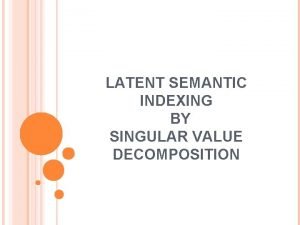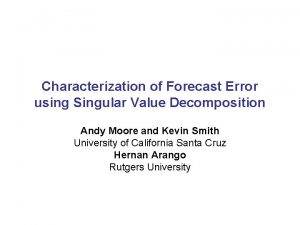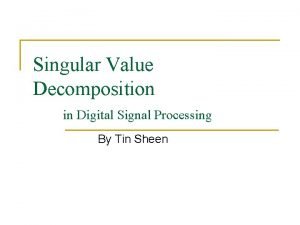Singular Value Decomposition COS 323 Underconstrained Least Squares





![SVD • Treat as black box: code widely available In Matlab: [U, W, V]=svd(A, SVD • Treat as black box: code widely available In Matlab: [U, W, V]=svd(A,](https://slidetodoc.com/presentation_image_h/bc0a1d0e7e77189bf2270ad6a9cf6324/image-6.jpg)


















- Slides: 24

Singular Value Decomposition COS 323

Underconstrained Least Squares • What if you have fewer data points than parameters in your function? – Intuitively, can’t do standard least squares – Recall that solution takes the form ATAx = ATb – When A has more columns than rows, ATA is singular: can’t take its inverse, etc.

Underconstrained Least Squares • More subtle version: more data points than unknowns, but data poorly constrains function • Example: fitting to y=ax 2+bx+c

Underconstrained Least Squares • Problem: if problem very close to singular, roundoff error can have a huge effect – Even on “well-determined” values! • Can detect this: – Uncertainty proportional to covariance C = (ATA)-1 – In other words, unstable if ATA has small values – More precisely, care if x. T(ATA)x is small for any x • Idea: if part of solution unstable, set answer to 0 – Avoid corrupting good parts of answer

Singular Value Decomposition (SVD) • Handy mathematical technique that has application to many problems • Given any m n matrix A , algorithm to find matrices U, V , and W such that A = U W VT U is m n and orthonormal W is n n and diagonal V is n n and orthonormal
![SVD Treat as black box code widely available In Matlab U W VsvdA SVD • Treat as black box: code widely available In Matlab: [U, W, V]=svd(A,](https://slidetodoc.com/presentation_image_h/bc0a1d0e7e77189bf2270ad6a9cf6324/image-6.jpg)
SVD • Treat as black box: code widely available In Matlab: [U, W, V]=svd(A, 0)

SVD • The wi are called the singular values of A • If A is singular, some of the wi will be 0 • In general rank (A ) = number of nonzero wi • SVD is mostly unique (up to permutation of singular values, or if some wi are equal)

SVD and Inverses • Why is SVD so useful? • Application #1: inverses • A -1=(V T)-1 W -1 U-1 = V W -1 UT – Using fact that inverse = transpose for orthogonal matrices – Since W is diagonal, W -1 also diagonal with reciprocals of entries of W

SVD and Inverses • A -1=(V T)-1 W -1 U-1 = V W -1 UT • This fails when some wi are 0 – It’s supposed to fail – singular matrix • Pseudoinverse: if wi=0, set 1/wi to 0 (!) – “Closest” matrix to inverse – Defined for all (even non-square, singular, etc. ) matrices – Equal to (ATA)-1 AT if ATA invertible

SVD and Least Squares • Solving Ax =b by least squares • x=pseudoinverse(A ) times b • Compute pseudoinverse using SVD – Lets you see if data is singular – Even if not singular, ratio of max to min singular values (condition number) tells you how stable the solution will be – Set 1/wi to 0 if wi is small (even if not exactly 0)

SVD and Eigenvectors • Let A =UWV T, and let x i be ith column of V • Consider A TA x i: • So elements of W are sqrt(eigenvalues) and columns of V are eigenvectors of A TA – What we wanted for robust least squares fitting!

SVD and Matrix Similarity • One common definition for the norm of a matrix is the Frobenius norm: • Frobenius norm can be computed from SVD • So changes to a matrix can be evaluated by looking at changes to singular values

SVD and Matrix Similarity • Suppose you want to find best rank-k approximation to A • Answer: set all but the largest k singular values to zero • Can form compact representation by eliminating columns of U and V corresponding to zeroed wi

SVD and PCA • Principal Components Analysis (PCA): approximating a high-dimensional data set with a lower-dimensional subspace Second principal component * ** * * Data points * * * First principal component * * *** Original axes *

SVD and PCA • Data matrix with points as rows, take SVD – Subtract out mean (“whitening”) • Columns of V k are principal components • Value of wi gives importance of each component

PCA on Faces: “Eigenfaces” Average face First principal component Other components For all except average, “gray” = 0, “white” > 0, “black” < 0

Using PCA for Recognition • Store each person as coefficients of projection onto first few principal components • Compute projections of target image, compare to database (“nearest neighbor classifier”)

Total Least Squares • One final least squares application • Fitting a line: vertical vs. perpendicular error

Total Least Squares • Distance from point to line: where n is normal vector to line, a is a constant • Minimize:

Total Least Squares • First, let’s pretend we know n, solve for a • Then

Total Least Squares • So, let’s define and minimize

Total Least Squares • Write as linear system • Have An=0 – Problem: lots of n are solutions, including n=0 – Standard least squares will, in fact, return n=0

Constrained Optimization • Solution: constrain n to be unit length • So, try to minimize |An|2 subject to |n|2=1 • Expand in eigenvectors ei of ATA: where the i are eigenvalues of ATA

Constrained Optimization • To minimize subject to set min = 1, all other i = 0 • That is, n is eigenvector of ATA with the smallest corresponding eigenvalue
 Singular value decomposition for recommendation systems
Singular value decomposition for recommendation systems Singular value decomposition
Singular value decomposition Singular value decomposition
Singular value decomposition Singular value decomposition image compression
Singular value decomposition image compression Svd decomposition
Svd decomposition Cos 323
Cos 323 Cos 323°
Cos 323° Cos 323°
Cos 323° Cos 323°
Cos 323° Cos 323
Cos 323 Cos 323°
Cos 323° Square root of 323
Square root of 323 Cos 323
Cos 323 Cos 323
Cos 323 Cos 323
Cos 323 Sum of squares decomposition
Sum of squares decomposition How many squares
How many squares 4 squares = 5 9 squares =
4 squares = 5 9 squares = Least squares regression line definition
Least squares regression line definition Observation equation in least square adjustment
Observation equation in least square adjustment Least squares regression line statcrunch
Least squares regression line statcrunch Lms cis
Lms cis Recursive least squares derivation
Recursive least squares derivation Constrained least square filtering
Constrained least square filtering 4d3d41669541f1bf19acde21e19e43d23ebbd23b
4d3d41669541f1bf19acde21e19e43d23ebbd23b
